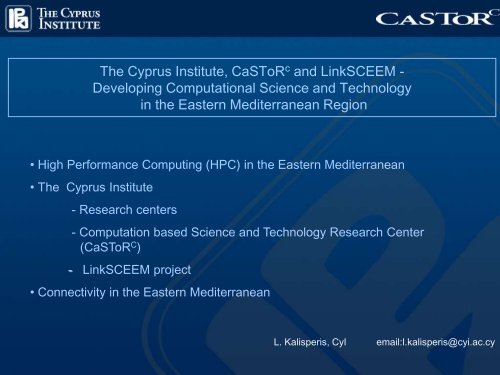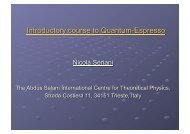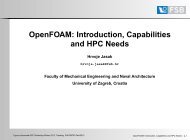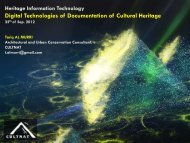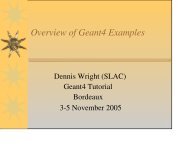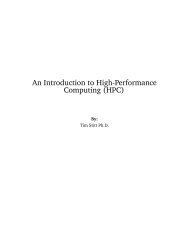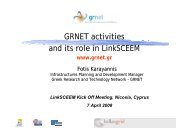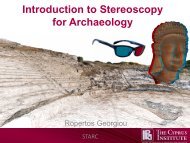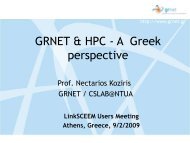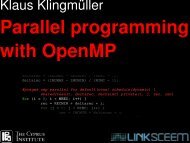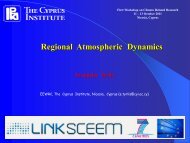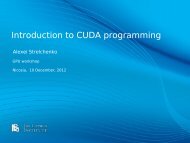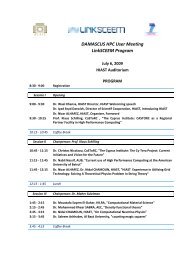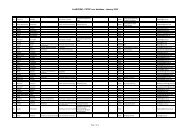The Cyprus Institute, CSTRC and LinkSCEEM
The Cyprus Institute, CSTRC and LinkSCEEM
The Cyprus Institute, CSTRC and LinkSCEEM
- No tags were found...
You also want an ePaper? Increase the reach of your titles
YUMPU automatically turns print PDFs into web optimized ePapers that Google loves.
<strong>The</strong> <strong>Cyprus</strong> <strong>Institute</strong>, CaSToR c <strong>and</strong> <strong>LinkSCEEM</strong> -Developing Computational Science <strong>and</strong> Technologyin the Eastern Mediterranean Region• High Performance Computing (HPC) in the Eastern Mediterranean• <strong>The</strong> <strong>Cyprus</strong> <strong>Institute</strong>- Research centers- Computation based Science <strong>and</strong> Technology Research Center(CaSToR C )- <strong>LinkSCEEM</strong> project• Connectivity in the Eastern MediterraneanL. Kalisperis, CyI email:l.kalisperis@cyi.ac.cy
HPC in the Eastern MediterraneanComputational resources are much less than in other regions of the world
Countries in TOP500 listRanked according to the number of facilities in TOP500 list
TeraflopsCapacity of Countries in theTOP500 list12001000USA ~ 66%UK, Germany &France ~ 15%8006004002000
<strong>The</strong> <strong>Cyprus</strong> <strong>Institute</strong>• A research <strong>and</strong> educational Institution dedicated to the advancement of knowledge• Envisioned to become a regional research Institution with a global perspective• Based in <strong>Cyprus</strong> but international in its membership <strong>and</strong> outlook• An <strong>Institute</strong> based on issue oriented research centers being developed in partnershipwith established world class institutions• Overseen by the <strong>Cyprus</strong> Research <strong>and</strong> Educational Foundation (CREF) a non-profit,non-governmental organization governed by an international Board of Trustees that isresponsible for the development of the <strong>Institute</strong>
Development of CyI• Formally established in 2005 with the signing of an agreement with MIT for thedevelopment of the first center of the <strong>Institute</strong>, the Energy, Environment <strong>and</strong> WaterResearch Center (EEWRC)• Operations started in September 2007 when the top leadership of the <strong>Institute</strong> tookoffice: President <strong>and</strong> Vice-President of research• <strong>The</strong> formal inauguration of EEWRC took place December 2007 <strong>and</strong> since thenseveral research scientists have joined the Center• <strong>The</strong> development of the next two research Centers is advancing:- <strong>The</strong> Science <strong>and</strong> Technology for Archaeology Research Center (STARC)- <strong>The</strong> Computation-based Science <strong>and</strong> Technology Research Center (CaSToR C )• <strong>The</strong> planning of two more centers will start when STRAC <strong>and</strong> <strong>CSTRC</strong> are launched:- Biology <strong>and</strong> Human Health- Economic Development <strong>and</strong> Conflict resolution
Research Centers: EEWRCI. Energy, Environment <strong>and</strong> Water (EEWRC)Addresses science, technology <strong>and</strong> policy issues concerning energy resources, production<strong>and</strong> management, water usage <strong>and</strong> management, <strong>and</strong> numerous environmental issuessuch as climate changes <strong>and</strong> their socioeconomic consequences <strong>and</strong> production <strong>and</strong>development of alternative forms of energy.Research areas:• In the field of energy research: Quantify the potential for reducing the use ofconventional energy sources exploring novel technologies for producing, storing <strong>and</strong>transmitting energy, with a focus on the applications of material sciences.• In the field of environmental research: Evaluate regional climate change <strong>and</strong> its socioeconomicimpact. This includes assessing its impact on natural resources (particularlywater) <strong>and</strong> economic development, as well as identifying <strong>and</strong> evaluating strategies toameliorate the negative impact, including the associated political <strong>and</strong> socialrepercussions.
Research Centers : STARCII.Science <strong>and</strong> Technology for Archaeology (STARC):Devoted to the development, introduction <strong>and</strong> use of advanced science<strong>and</strong> technologies in Archaeology <strong>and</strong> Cultural Heritage.Its research activities have a strong multi-disciplinary approach enhancing knowledge inCultural Heritage (CH) in the region, through new ways of reasoning with informationtechnologies, natural <strong>and</strong> material sciences.Research topics include:- Natural <strong>and</strong> Material Sciences applied to Archaeology <strong>and</strong> Cultural Heritage- Digital Heritage (DH); Information <strong>and</strong> Communication Technologies (ICT);digital documentation <strong>and</strong> semantics, scientific visualization <strong>and</strong> virtual realitymethods- Diagnostics for CH conservation, such as chemical <strong>and</strong> physical analyses for thepreservation of heritage items- Maritime <strong>and</strong> underwater archaeology technology.
Development of CaSToR CIII.Computation based Science <strong>and</strong> Technology2002:• Assessment report: Identified 7 Research Centers with the potential of achieving worldclass st<strong>and</strong>ards• Computation based Science <strong>and</strong> Technology Research Center (CaSToR C ): Interdisciplinarywith world class facilities, interlinked to the research areas of the other CentersCurrent view:• Development of CaSToR C is seen as a necessary complement for the research activities ofother CyI Centers <strong>and</strong> in particular with the two first Centers EEWRC <strong>and</strong> STARC• Key strategy is the development of the infrastructure tailored to the scientific needs of thecommunity• Should be developed as a national/regional facility• Should include its own research agenda in computational science• Educational <strong>and</strong> training programs seen as essential
Staged Development• Being developed in partnership with the National Center for SupercomputingApplications (NCSA) of the U. of Illinois• A Memor<strong>and</strong>um of Underst<strong>and</strong>ing was signed between CyI <strong>and</strong> the University ofIllinois in July 2007, followed by a Collaboration agreement in December 2007,that aims at the planning <strong>and</strong> development of the Center with joint research <strong>and</strong>educational activities• Preparation of Enterprise Plan with NCSA has been completed identifying thedirections that can be pursued aiming at:- Achievement of world class research activity- Regional relevance• Discussion of Enterprise Plan by the Scientific Advisory Committee on Nov. 7 th , 2008<strong>and</strong> recommendation to BoT• Approval of Enterprise Plan by BoT in January 2009 - will open the way for thelaunching of the center after governmental acceptance
Current stage CaSToR CCurrent administrative structure:• Governed by an Interim Governing Board until the Director is in place• Two scientific coordinators are hired to help with the development of the Center• Operations started with the purchase of a 24-node IBM cluster in August 2008• Research program on GPUs in the area of Lattice QCD approved• European project <strong>LinkSCEEM</strong> provides initial funding for the planning of the Center• CaSToR C signed an MoU with the Partnership for Advanced Computing in Europe(PRACE) on October 29 th , 2008http://cstrc.cyi.ac.cy/
<strong>LinkSCEEM</strong> project• A support action funded by the European Commission (DG-INFSO) through theFP7-Capacities program for policy development of e-Infrastructures• A consortium of eight members under the coordination of the <strong>Cyprus</strong> <strong>Institute</strong>• Started on April 1 st , 2008 with a duration of 18 months• Kick-off <strong>and</strong> first users meeting held in Nicosia on April 8 th , 2008http://www.linksceem.eu/
<strong>LinkSCEEM</strong> project<strong>The</strong> objectives of the Support Action are the following:• <strong>The</strong> integration of the CaSToR C of the <strong>Cyprus</strong> <strong>Institute</strong> into the European high-performancecomputing <strong>and</strong> computational science environment• <strong>The</strong> organization of remote <strong>and</strong> trans-national access by virtual communities of users from theEastern Mediterranean region• <strong>The</strong> execution of a feasibility study for the creation of a regional research networkinterconnecting the Eastern Mediterranean countries with each other <strong>and</strong> with <strong>Cyprus</strong>• Outreach activities, in order to ensure the dissemination of the outcome of studies <strong>and</strong> actionsincluded in the <strong>LinkSCEEM</strong> project among decision makers <strong>and</strong> the research <strong>and</strong> educationalcommunities
<strong>LinkSCEEM</strong> actions• <strong>The</strong> assessment of needs for computational resources within the scientific community of <strong>Cyprus</strong><strong>and</strong> the Eastern MediterraneanSurvey set up: Form provided at www.linksceem.eu/survey <strong>and</strong> an online survey at NCSAhttp://www.zoomerang.com/Survey/?p=WEB227MA8276UH• <strong>The</strong> assessment of HPC resources in the region• Integration with European facilities - the participation of CaSToR C in PRACE an important firststep• <strong>The</strong> planning of the access of users - initial phase with a machine to be acquired by end of 2009• <strong>The</strong> preparation of research <strong>and</strong> educational program in computational science in collaborationwith NCSA <strong>and</strong> other partners• A feasibility study for the amelioration of the network connectivity in the region - EUMEDconnect• Dissemination <strong>and</strong> outreach actions, including an International Conference <strong>and</strong> several usersworkshops
Users meetings• Users meeting in Nicosia attracted scientists from Israel, Egypt, Jordan, Greece, Syria <strong>and</strong>Lebanon• Users meeting in Amman co-organized by CaSToR C , JUNET <strong>and</strong> SESAME on November6 th , Tel Aviv co-organized by <strong>CSTRC</strong>, the Inter-University Computation Center (IUCC) <strong>and</strong>the Tel Aviv University (TAU).<strong>The</strong> objectives are:- to provide a forum to high-performance computing (HPC) users <strong>and</strong> providers- to promote collaboration among computational scientists in the EasternMediterranean- to present <strong>and</strong> discuss the development of CaSToR C- to learn about the available HPC infrastructures in the region, <strong>and</strong> the waysthey currently serve their user- to initiate a user community around the planned HPC facility of CaSToR C<strong>The</strong> session in Cairo organized by CaSToR C <strong>and</strong> SESAME was devoted to computationalaspects of synchrotron research, within the 7th SESAME users meeting on November 20 th .<strong>The</strong>main objective is to assess the computational needs related to processing SESAMEsynchrotron data <strong>and</strong> how CaSToR C could contribute to serving them. Keynote presentation:Cyber Infrastructure for SR research by Rudolf Dimper (Head of Computing Services,European Synchrotron Radiation Facility)• Other meetings are planned during the first half of this year in Turkey, Greece <strong>and</strong> Egypt
Regional facility• Provide an open user facility at the multi-teraflop scale - regarded as crucial to thesustainability of the center• Serve as a portal to resources in Europe <strong>and</strong> the US at the petaflop scale for the Cypriot<strong>and</strong> regional scientific communityMoU will be signed with the Partnership for Advanced Computing in Europe (PRACE), aconsortium of 17 European countries.<strong>The</strong> aim of PRACE is to build a Europeanecosystem of supercomputing facilities at the top of which will be petascale facilities. <strong>The</strong>Government of <strong>Cyprus</strong> through the Planning Bureau endorsed <strong>CSTRC</strong> as the officialrepresentative of <strong>Cyprus</strong> in this project.• Offer regional <strong>and</strong> international educational programs in computational science<strong>and</strong> technology in collaboration with NCSA, EU HPC facilities <strong>and</strong> regional Institutions
Organization of CaSToR CProposed organizational structure of CaSToR C has three divisions:• <strong>Cyprus</strong> Supercomputing Center: Operates the <strong>Institute</strong>'s major computing, datastorage <strong>and</strong> visualization systems. <strong>The</strong> CySC also provides a consulting office,performance engineering program, <strong>and</strong> a training program, which are essential tomaximizing the impact of these resources• Cyberinfrastructure Division: Develops <strong>and</strong> supports the collaboration, e-science<strong>and</strong> e-education cyberinfrastructure <strong>and</strong> cyberenvironments needed by CyI'sresearch programs. Most of these activities in this division will be in support of theresearch programs in the other research centers <strong>and</strong> collaborating institutions• Research Division: Focuses on research areas that are critical to the success ofCyI, complement expertise in the region, <strong>and</strong> produce research of internationalcaliber. <strong>The</strong> initially targeted areas include: environmental science <strong>and</strong>engineering, digital cultural heritage, scientific computing, <strong>and</strong> basic sciences
Connectivity in EuropeDark fibre2.5Gbps10 Gbps10Gbps<strong>Cyprus</strong> has theslowest connection2x155Mbps2.5Gbps
Connectivity in the Mediterranean2.5 Gbps155 Mbps155 Mbps34 Mbps 8 MbpsEUMEDCONNECT
Available Capacity in Connectivity2x562Mbps2x565 Mbps2x5 Gbps565 Mbps2x565 Mbps2x2.5 GbpsOptical Fibres
Research activities in computational science• CaSToR C :- large-scale climate modeling for the Eastern Mediterranean region (EEWRC) -analysis of data generated by the SESAME synchrotron facility in Jordan- detailed storage <strong>and</strong> visualization of archaeological cultural informationranging from manuscripts to entire monuments (STARC)Egypt as well as other countries in the region have strong research groups in these areas<strong>and</strong> establishing collaborations is very important to the development of CaSToR Ce.g. Biodiversity, High Energy Physics, Protein Structure (Cairo University),For these regional activities to flourish around <strong>CSTRC</strong> we need good connectivity among us<strong>and</strong> to EU
Summary• <strong>Cyprus</strong> <strong>Institute</strong> is involving very rapidly recruiting scientists worldwide- work together oncommon projects attracting talent to come to the region• CaSToR C expected to be operational in 2009 after government approval- setup users community <strong>and</strong> research teams on projects of common interests withEgypt <strong>and</strong> other countries in the region- recruit talented computational scientists drawing from regional human resources- act as a portal to EU facilities enabling scientists to access EU HPC facilitiespresence in EU secured as member of PRACE- use funding for a medium scale machine by end 2009 open to users from the region- use <strong>LinkSCEEM</strong> project to make contacts with scientists in the area <strong>and</strong> promotecollaboration. Users meetings in Jordan <strong>and</strong> Egypt by end of 2008; Turkey, Greece<strong>and</strong> Egypt by early 2009- start research activities <strong>and</strong> educational programs in HPC in cooperation with NCSAinvolving Institutions in the region as well as European partners: NIC, Julich, Germany,SARA, Netherl<strong>and</strong>s <strong>and</strong> CSCS, Switzerl<strong>and</strong>• Address the connectivity issue in the region - need to work together <strong>and</strong> with GEANT <strong>and</strong>EUMEDCONNECT to improve connectivity


